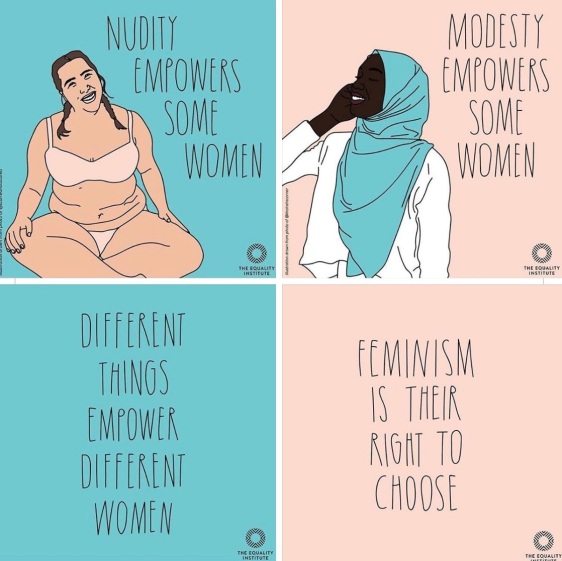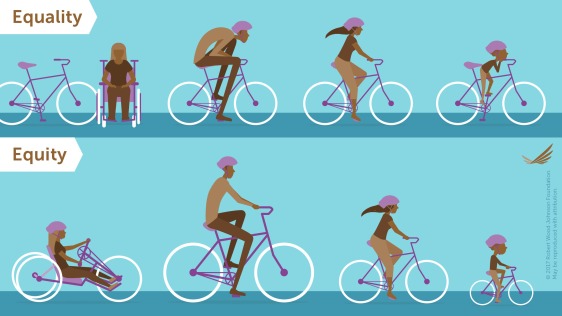
Harini Narayan is a Student Staff member at the Women’s Center. She is an MLLI major and is currently a co-facilitator of the Women’s Center’s discussion groups, Between Women.
The lyrics, “I am woman, hear me roar!,” made history thanks to singer Helen Reddy, lending an amazingly catchy slogan to the movement of women’s rights. The phrase itself is innocuous, associating strength with femininity. Girl Power and the Future is Female are other popular slogans adopted by modern-day feminists (these examples are literally lifted from shirts that I own) with the goal of empowering their users.
Empowerment is like a haircut: the styles that suit people largely vary, and not everyone prefers what looks conventionally attractive.

A huge issue with modern-day feminism, or the Second Wave, is the Westernized perversion of what liberation looks like. This concept is commonly dubbed, “white feminism,” and usually consists of white women enforcing standards of equality centered solely around their status while simultaneously disregarding the privilege afforded to them by their race. This type of indirect discrimination is often not purposeful, but can be a product of ignorance. When people do not consider the varied lens through which others experience the world, they do not consider the effects of multifaceted identities on marginalized people’s perspectives. Intersectional identities overlap like different colors, creating new ones through these combinations. If sexual identity and ethnicity are the colors red and blue, respectively, then the intersectional identity they create would be purple. However, when those representative colors are not alike between individuals, confusion arises: one person’s purple identity can be misidentified by someone who does not see both blue and red; to someone who cannot see blue, red is the only identity that is recognized. Building bridges toward intersectionality begins with understanding this concept of different lenses. No two people have identical sets of lenses, but that does not invalidate the existence of lenses unlike our own. I may not have a blue lens to mix with my red, but perhaps my intersectional identity is represented by orange, made by the same red with my unique yellow. What makes an inclusive feminist is a person’s ability to recognize and validate the identities that are unlike their own and respect cultures to which they might not belong or even understand.
Upon reading the phrase, “Forcing opinions about religious head coverings on female and nonbinary Muslims,” what do you imagine? Is it a man forcing his wife or daughter to wear a hijab, or is it a “free the nipple” Westerner telling her/them to take it off and conform to their idea of freedom? White feminism is very exclusionary and, more often than not, is also subtly cissexist and racist. It’s what decrees that all Muslims that choose to wear head coverings must be oppressed, because why else would they do that? It can’t possibly be their own choice. An intersectional feminist, Muslim or not, would be able to understand that freedom from oppression lies in the ability to make decisions for oneself.
Exclusionary logic undermines women under the guise of liberation: it implicitly creates a preconception of what freedom looks like. Objectively, housewives that choose their own lifestyle are every bit as empowered as a female CEO. The power lies in the freedom to make such decisions for oneself. Making the assumption that a woman can’t be free unless she emulates men in mannerisms, occupation, or lifestyle perpetuates misogynistic stereotypes that only further the stigmatization of feminism. The concept of “white feminism” is overtaking a movement that is supposed to represent equity over equality.

The concept of equity vs. equality is pictured above. Equality is everyone receiving the same exact bike, even though only one person of the four can ride it comfortably. Equity, on the other hand, is everyone receiving something catered to their individual needs for a result of all four people being able to comfortably ride their own bikes.
Perception of women is an equity vs. equality issue, as well. Empowerment is not a one-size-fits all concept, but rather it is the readily available option to live on one’s own terms, without answering to stereotypes or discrimination. Empowerment should mean nobody looks down on nurses, teachers, or homemakers, as if their occupations are unworthy of respect because they are female-dominated fields. For some women, empowerment is Helen Reddy’s, “I am woman, hear me roar!” but for some, empowerment is quiet and unassuming. Power comes from the ability to make a choice, and to have that choice be respected.
For more information on the concepts discussed, here are some resources!
- Harvard International Review, The Struggle of the Veiled Woman
- TEDTalk, Is Equality Enough?
- Bustle, What is White Feminism? Here Are 7 Sneaky Ways It Shows Up Into Your Life





